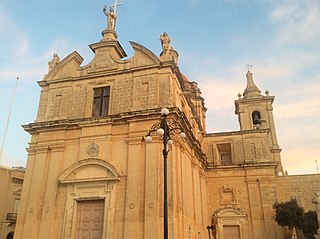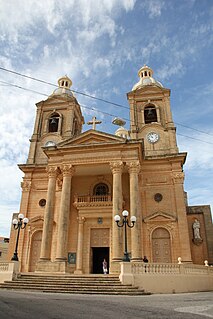
Gudja is a village in the Southern Region of Malta, with a population of 3,148 as of March 2017. The village is located on high grounds, south of Valletta. It is administered by the Gudja Local Council. A number of schools, clubs, public gardens and recreations places are found around the village. The Malta International Airport is also located in Gudja.

Naxxar is a small city in the Northern Region of Malta, with a population of about 14,891 people as of March 2014. The Naxxar Church is dedicated to Our Lady of Victories. The annual village feast is celebrated on 8 September. Naxxar was formerly known for hosting the Maltese International Trade Fair at Maltese International Trade Fair Grounds.

Qrendi is a small village in the Southern Region of Malta, with a population of 2752 people as of March 2014. It is located close to Mqabba Żurrieq and Siggiewi. Within its boundaries are two well-known Neolithic temples called Mnajdra and Ħaġar Qim. In this village two feasts are held annually. The feast of Our Lady of Lourdes is celebrated either on the last Sunday of June or on the first Sunday of July, with 15 August the titular feast of the Ascension of Our Lady. This feast is popularly known as the feast of Santa Maria.

Mqabba is a town in the Southern Region of Malta. It has a traditional Maltese village layout, with a population of about 3,300 inhabitants. The focal point is the Parish Church of the Assumption, found at the core of the village. It has two band clubs, a number of gardens and a list of national monuments.

Maltese architecture has its origins in prehistory, and some of the oldest free-standing structures on Earth – a series of megalithic temples – can be found on Malta. The islands were colonized by the Phoenicians and later the Romans, who established the cities of Melite and Gaulos. Although these were substantial settlements and are known to have had numerous temples, churches and palaces, few remains have survived apart from some architectural fragments.

The Cittadella, also known as the Castello, is the citadel of Victoria on the island of Gozo, Malta. The area has been inhabited since the Bronze Age, and the site now occupied by the Cittadella is believed to have been the acropolis of the Punic-Roman city of Gaulos or Glauconis Civitas.

St. George's Basilica or the Basilica and Collegiate Parish Church of Saint George, also simply known as San Ġorġ in Maltese, is a historic Baroque church situated in the middle of Victoria, the ancient "Ħaġar" – the capital of Gozo, the second largest island in the Maltese archipelago, and is surrounded by a maze of old narrow streets and alleys. Today's basilica was built between 1672 and 1678.
St. Basil's Church may refer to:

The Chapel of St Mary is a medieval chapel located in Bir Miftuħ, limits of Gudja, Malta.

St Basil's Chapel is a Roman Catholic medieval church located in Mqabba, Malta. It is the only church building in Malta dedicated to St Basil the Great.

The Chapel of St John the Evangelist is a small Roman Catholic church located in the now uninhibited area known as Ħal Millieri which today forms part of the village of Żurrieq in Malta.

St George's Chapel or the Church of St George the Martyr, is a small Roman Catholic church located in the village of Birżebbuġa, Malta.

The Church of St Mary or more formally, the Parish church of the Assumption of Mary is a Roman Catholic parish church located in the southern village of Mqabba in Malta.

Wardija is a hamlet in St. Paul's Bay, Malta, about 363 feet above sea level. Its name is corrupted from the Sicilian or Italian word guardia, meaning to watch). Although the name of the hamlet has Arabic lexicons, it was probably named later when Maltese, then an Arabic dialect, remained a dominant language. The hamlet is bordered with Bidnija, Buġibba, San Martin and Pwales. Several archeological remains are found in the whereabouts, proving that it was inhabited in pre-history and the Roman period, and it has always been mainly a rural village. From the 16th till the 18th-centuries it saw a shift into a hunting zone with the construction of several hunting lodges and chapels.

The Chapel of Our Lady of Sorrows is a 17th-century Roman Catholic church located in the village of Mqabba, in Malta.

St Catherine's Chapel officially the Church of St Catherine and St Peter is an 18th century Roman Catholic church located in Mqabba, Malta.

St Paul's Church, formally known as The Parish Church of the Conversion of Saint Paul, is a Roman Catholic parish church located in the village of Safi in Malta.
Gio Nicola Buhagiar was a Maltese painter.

The Parish Church of the Assumption of the Blessed Virgin Mary into Heaven is a Roman Catholic parish church in Dingli, Malta, dedicated to the Assumption of Mary. It was constructed in various stages between 1903 and 1973 on the site of a previous church which had been built between 1678 and 1680.

Ġużè or Joseph Damato was a Maltese architect who designed a number of churches and other ecclesiastical buildings during the 20th century. He was a pioneer of the use of reinforced concrete in Malta, and his most notable works include the Church of Christ the King in Paola, the Church of St John the Baptist in Xewkija and the Carmelite church in Valletta. Some of the buildings he designed were completed decades after his death.


















